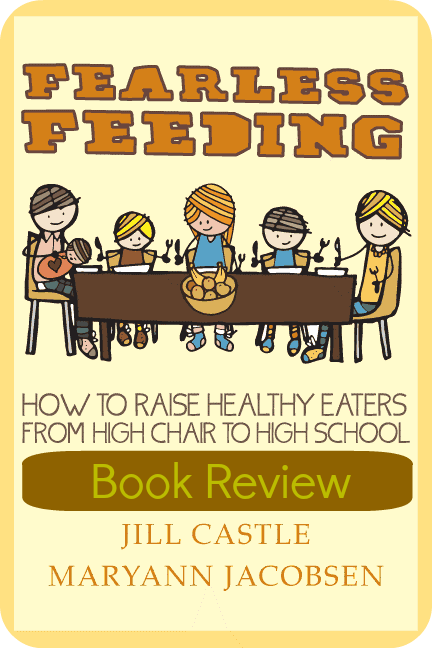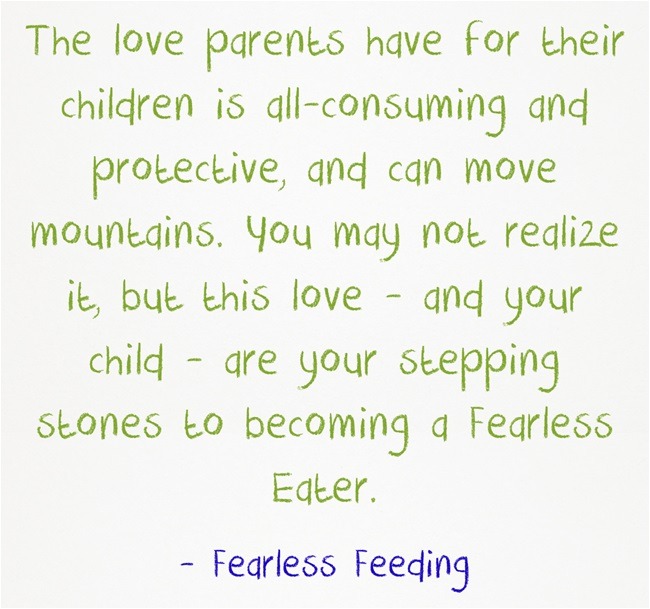One of the primary roles of every parent is ensuring that his or her children are well fed. It is a big task: in fact, it is estimated that a parent will feed their child 28,000 times before he leaves for college! In most households, the purchasing, preparation, and serving of food tends to fall on one parent, the “nutritional gatekeeper,” who, consequently, influences about 72 percent of all the food a family eats. This is huge responsibility, and one that elicits fear in many parents. I am not yet a parent, but as I mentioned in my review of Ellyn Satter’s book on childhood nutrition, I am already intimidated by – and preparing for – my future role as a nutritional gatekeeper.
My desire to front-load my education about childhood feeding led me to Fearless Feeding: How to Raise Healthy Eaters from High Chair to High School, a book written by two registered dietitians who want to help parents navigate the challenging road of raising healthy, well-fed children. As mothers themselves, authors Jill Castle and Maryann Jacobsen understand that that the responsibilities of feeding can be overwhelming. Their book provides a comprehensive guide to childhood feeding and nutrition, helping parents determine what, when, and how to feed their children at every age.
The first chapter of Fearless Feeding guides parents in understanding how to lay a foundation for implementing healthy feeding practices with their children. In this chapter, the authors explain that a child’s diet should follow the 90:10 rule, with 90 percent of their diet consisting of “nourishing” and “half-and-half foods” (terms that are fully outlined in the book), and the remaining 10 percent made up “fun foods.” They also explain HOW to feed your child (borrowing heavily from Ellyn Satter’s Division of Responsibility), and they help parents identify their current feeding style. The chapter concludes with an exploration of predictable childhood behaviors regarding food.
The next four chapters correspond to the developmental stage of a child: infants and young toddlers, toddlers and preschoolers, school-age children, and teenagers. These chapters outline the nutritional needs and appropriate feeding strategies for each stage of development. The authors provide sample meal plans and age-appropriate recipes for every age, and they use real-life examples to illustrate how parents have successfully implemented fearless feeding techniques.
The second half of Fearless Feeding addresses feeding at a broader level, beginning with a chapter that helps parents understand their own attitudes and actions regarding food. I found this chapter particularly insightful and was reminded that in order to become a fearless feeder, I will need to be a fearless eater! Another chapter of the book is dedicated to common feeding challenges, such as food allergies, weight problems, picky eating, and eating disorders. I can imagine that this chapter would be particularly useful for a parent who was encountering one of these issues and felt unsure of how to proceed. The book’s final chapter rounds out the fearless feeding approach by instructing parents on how to use meal planning and shopping strategies to make family meals a reality.
In coming together to write Fearless Feeding, Castle and Jacobsen set out to write a book that would ”change the current fear-based model of feeding to one filled with joy and confidence.” They hoped that their book would become THE essential guide for nutrition-conscious parents of children of all ages. Did they succeed? Absolutely! Fearless Feeding is a treasure trove of information, addressing nearly every imaginable issue related to nutrition and feeding. Despite the broad scope of their subject matter, the authors’ relatable writing style makes the information accessible and informative, without feeling too much like a textbook. And while it is very comprehensive, Fearless Feeding is incredibly easy to navigate: I read the book cover-to-cover, but the book’s structure – which makes effective use of tables, sidebars, and anecdotes – easily lends itself to use as a topical reference guide. Finally, parents can trust the strategies and suggestions put forth in Fearless Feeding because the authors clearly did their research, as evidenced by the hundreds of notes and references listed at the back of the book. It is clear that Fearless Feeding is baked by experience, common sense, AND the most up-to-date studies!
I found Fearless Feeding to be a highly enjoyable read . . . but, I am admittedly a “nutrition nerd” and “psychology junkie,” and I recognize that a book about macro nutrients and cognitive development *might* not be the sort of book that most people would pick up for “a bit of light reading.” (<– Yes, that was a Hermione Granger reference.) Nevertheless, it IS the type of book that every parent should have on their bookshelf. I will definitely be holding on to my copy of Fearless Feeding, knowing that it will become an invaluable resource if/when I have children of my own to feed. Until then, I will be recommending this book to all of my friends who are striving to become fearless feeders.
My Rating: 4.5 out of 5 Stars.


[…] I Listen: I LOVE the book on feeding that Jill Castle coauthored with Maryann Jacobson (reviewed here) and was excited to hear that Jill was now hosting her own podcast! Feeding our children is […]
Ditto to Maryann’s comment–such a nice review! Thank you!!
Thanks, Jill! And thanks for the work that you do – you are making a difference in the lives of many!
[…] the same need. Some books I read for enjoyment and escapism. Other books are selected for their educational value, or their literary merit. I read memoirs so that I can experience the world through another […]
Thanks so much for the wonderful review!! Much appreicated
Thank you for writing such a wonderful book!